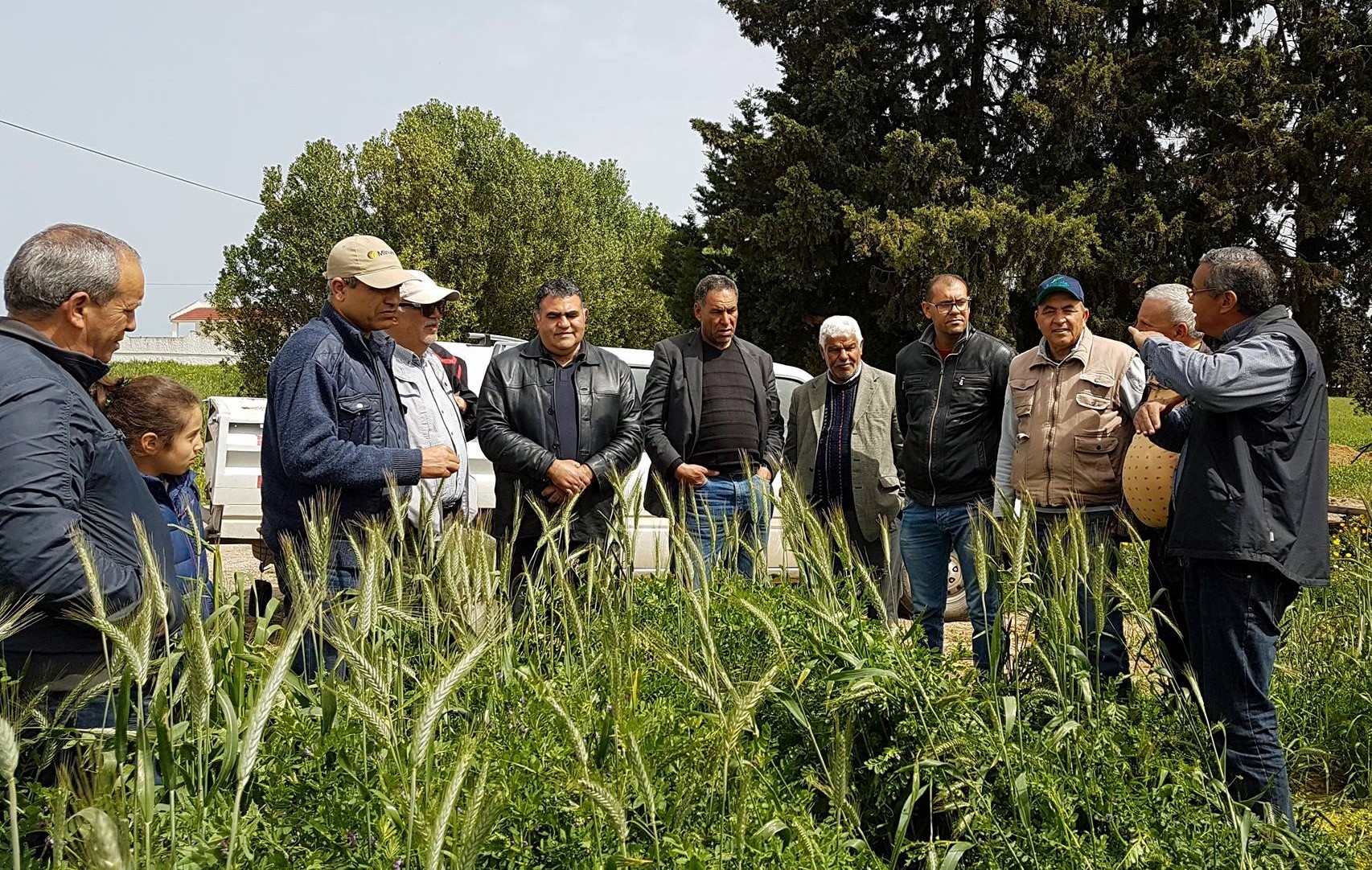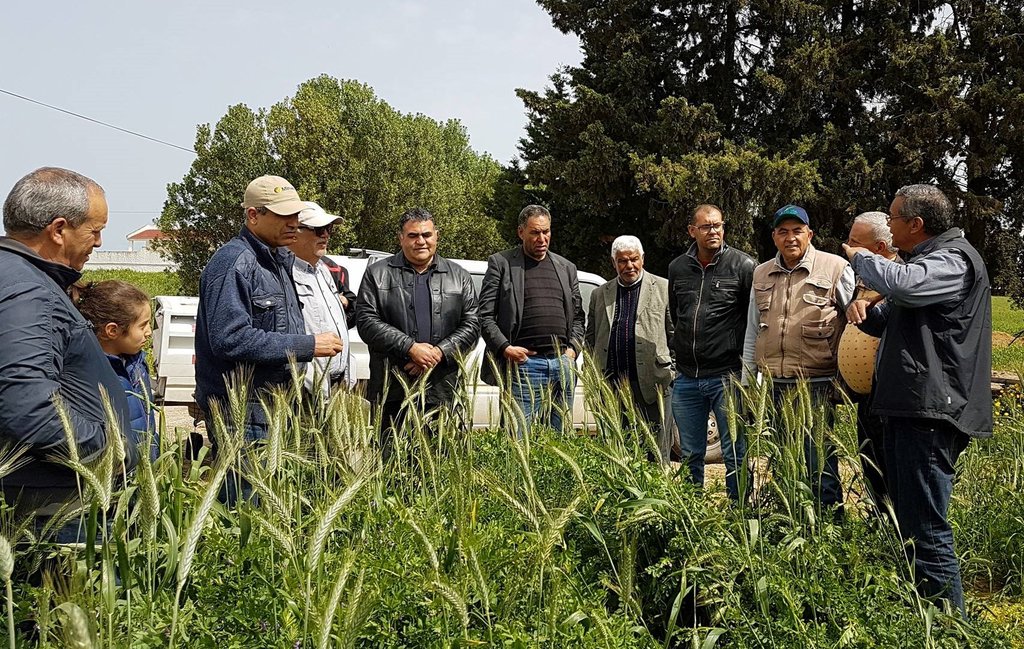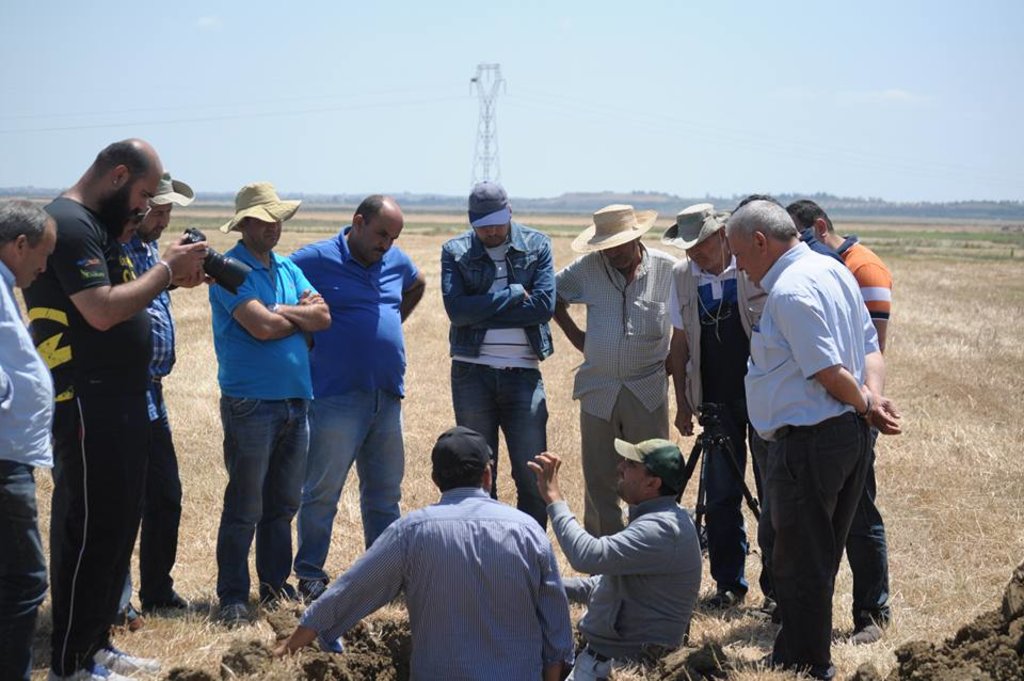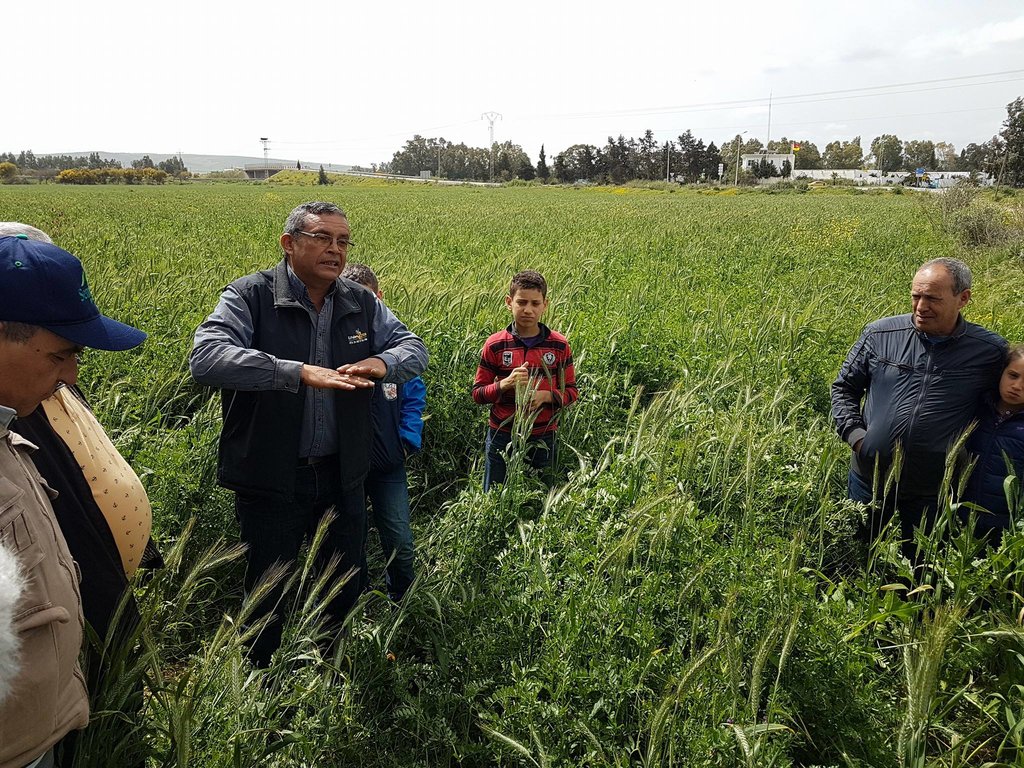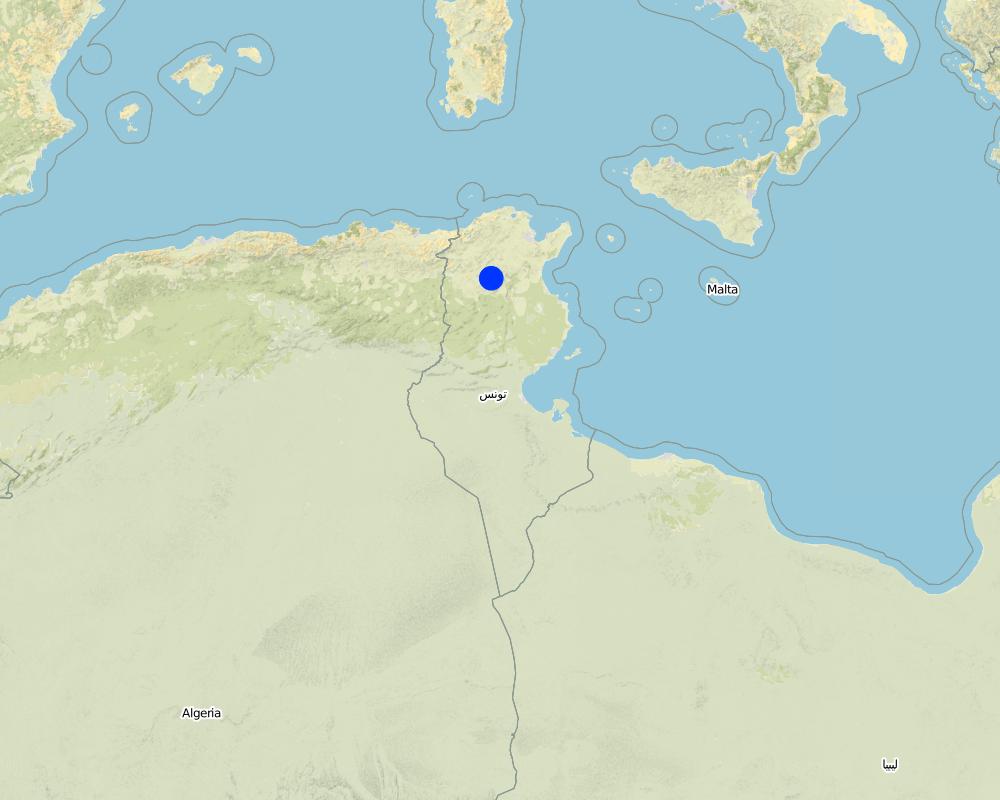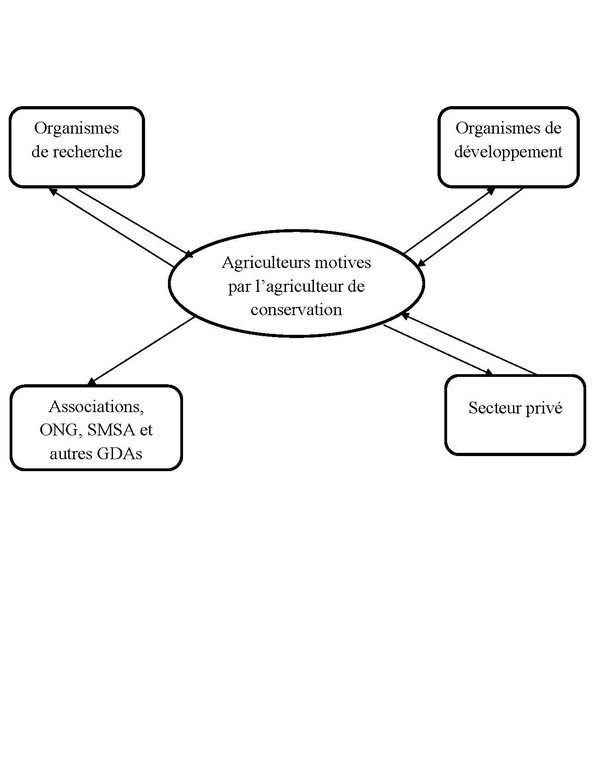Un réseau informel pour l'implémentation de l'agriculture de conservation [Tunisia]
- Creation:
- Update:
- Compiler: Donia Mühlematter
- Editors: Donia Mühlematter, Houcine Angar
- Reviewer: Donia Mühlematter
Le groupe de semis direct
approaches_3725 - Tunisia
View sections
Expand all Collapse all1. General information
1.2 Contact details of resource persons and institutions involved in the assessment and documentation of the Approach
Key resource person(s)
SLM specialist:
Angar Houcine
Institut National des Grandes Cultures
Bousselem, Jendouba
Tunisia
Name of project which facilitated the documentation/ evaluation of the Approach (if relevant)
Decision Support for Mainstreaming and Scaling out Sustainable Land Management (GEF-FAO / DS-SLM)Name of the institution(s) which facilitated the documentation/ evaluation of the Approach (if relevant)
Institut National des Grandes Cultures (INGC) - Tunisia1.3 Conditions regarding the use of data documented through WOCAT
The compiler and key resource person(s) accept the conditions regarding the use of data documented through WOCAT:
Yes
1.4 Reference(s) to Questionnaire(s) on SLM Technologies
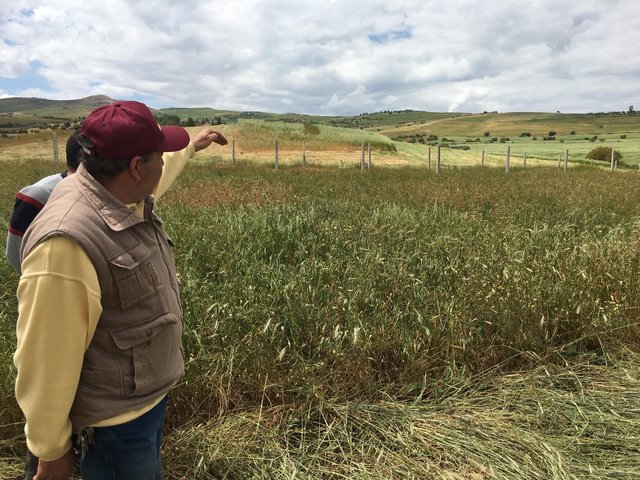
Agriculture de Conservation [Tunisia]
L’agriculture de conservation est une technologie basée sur trois principes : la perturbation minimale du sol, la couverture permanente des sols et la diversification de cultures en rotations ou en séquences.
- Compiler: Donia Mühlematter
2. Description of the SLM Approach
2.1 Short description of the Approach
La création d'un réseau informel pour le développement des mesures de conservation des terres en agriculture de conservation.
2.2 Detailed description of the Approach
Detailed description of the Approach:
Les agriculteurs ont remarqué que la fertilité de leurs sols est en continuelle dégradation avec une forte érosion hydrique avec l'augmentation des couts de production tels que le travail du sol, les intrants et les frais d'entretien des matériels agricoles et le cout de gasoil. C'est parce que quand ils ont été sensibilisés par des projets internationaux d'agriculture de conservation, ils ont adopté l'idée de tester les techniques de l'agriculture de conservation et aprés l'adoption totale dans leurs propres parcelles.
Ensuite et grace au support des experts nationaux et internationaux lors des journées d'informations et des écoles champs et des voyages d'échange, s'est formé un réseau informel basé sur des amitiés entre des agriculteurs nationaux et internationaux.
2.3 Photos of the Approach
2.4 Videos of the Approach
Location:
Krib, Siliana
2.5 Country/ region/ locations where the Approach has been applied
Country:
Tunisia
Region/ State/ Province:
Krib, Siliana
Map
×2.6 Dates of initiation and termination of the Approach
Indicate year of initiation:
1999
If precise year is not known, indicate approximate date when the Approach was initiated:
10-50 years ago
Comments:
Approche en cours.
2.7 Type of Approach
- recent local initiative/ innovative
2.8 Main aims/ objectives of the Approach
Développer les bonnes pratiques / mesures de conservation en agriculture de conservation et partager les expériences et les connaissances.
2.9 Conditions enabling or hindering implementation of the Technology/ Technologies applied under the Approach
social/ cultural/ religious norms and values
- enabling
Échange et solidarité.
institutional setting
- enabling
collaboration/ coordination of actors
- enabling
Collaboration et coordination des agriculteurs et des experts.
legal framework (land tenure, land and water use rights)
- enabling
Encourager l'octroi des subventions spécifiques et le changements des lois et stratégies pour conserver des lois et stratégies pour conserver les sols.
policies
- enabling
land governance (decision-making, implementation and enforcement)
- enabling
knowledge about SLM, access to technical support
- enabling
L'agriculture de conservation est trés promotteuse en terme de GDT.
markets (to purchase inputs, sell products) and prices
- enabling
workload, availability of manpower
- hindering
other
- enabling
Séquestration de carbonne, réduction de la consommation d'énergie, conservation des resources naturelles telque le sol et l'eau.
3. Participation and roles of stakeholders involved
3.1 Stakeholders involved in the Approach and their roles
- local land users/ local communities
Des agriculteurs de Siliana, Bizerte, Kef...
- SLM specialists/ agricultural advisers
Experts de INGC.
- researchers
Professeurs universitaires.
- teachers/ school children/ students
étudiants
Réaliser des mémoires de recherche.
- NGO
- private sector
Fournisseurs.
- local government
INGC.
- international organization
CIRAD.
3.2 Involvement of local land users/ local communities in the different phases of the Approach
| Involvement of local land users/ local communities | Specify who was involved and describe activities | |
|---|---|---|
| initiation/ motivation | self-mobilization | Initiative innovante d'un groupe des agriculteurs. |
| planning | self-mobilization | Role moteur de l'agriculteur. |
| implementation | self-mobilization | |
| monitoring/ evaluation | self-mobilization |
3.3 Flow chart (if available)
3.4 Decision-making on the selection of SLM Technology/ Technologies
Specify who decided on the selection of the Technology/ Technologies to be implemented:
- land users alone (self-initiative)
Specify on what basis decisions were made:
- personal experience and opinions (undocumented)
4. Technical support, capacity building, and knowledge management
4.1 Capacity building/ training
Was training provided to land users/ other stakeholders?
Yes
Specify who was trained:
- land users
- field staff/ advisers
Form of training:
- on-the-job
- farmer-to-farmer
- demonstration areas
- public meetings
Subjects covered:
Sciences du sol, botanique, agronomie, et hydraulique.
4.2 Advisory service
Do land users have access to an advisory service?
Yes
Describe/ comments:
L'agriculteur est actif et motivé, qui cherche l'information et le conseil par ses moyens propres à l'extérieur de pays (CIRAD).
4.3 Institution strengthening (organizational development)
Have institutions been established or strengthened through the Approach?
- no
4.4 Monitoring and evaluation
Is monitoring and evaluation part of the Approach?
Yes
If yes, is this documentation intended to be used for monitoring and evaluation?
No
4.5 Research
Was research part of the Approach?
Yes
Specify topics:
- economics / marketing
- ecology
- technology
5. Financing and external material support
5.1 Annual budget for the SLM component of the Approach
If precise annual budget is not known, indicate range:
- 100,000-1,000,000
5.2 Financial/ material support provided to land users
Did land users receive financial/ material support for implementing the Technology/ Technologies?
Yes
If yes, specify type(s) of support, conditions, and provider(s):
Intrants agricoles (semences, produits phyto-sanitaires, fertilisant..), matériel agricole (semoirs, pulvérisateurs...), frais du transport de matériel agricole.
5.3 Subsidies for specific inputs (including labour)
- equipment
| Specify which inputs were subsidised | To which extent | Specify subsidies |
|---|---|---|
| tools | partly financed | Location gratuite des pulvérisateurs (projets et organismes de développement). |
- agricultural
| Specify which inputs were subsidised | To which extent | Specify subsidies |
|---|---|---|
| seeds | partly financed | Projets et organismes de développement. |
| fertilizers | partly financed | |
- other
| Other (specify) | To which extent | Specify subsidies |
|---|---|---|
| voyages d'échange | fully financed | Projets et organismes de développement. |
If labour by land users was a substantial input, was it:
- paid in cash
5.4 Credit
Was credit provided under the Approach for SLM activities?
No
5.5 Other incentives or instruments
Were other incentives or instruments used to promote implementation of SLM Technologies?
Yes
If yes, specify:
Voyages d'échange au Maroc, Algérie, France, Brésil, Liban, Syrie, Portugal, Espagne, Australie, Inde, Burkina Faso...
6. Impact analysis and concluding statements
6.1 Impacts of the Approach
Did the Approach empower local land users, improve stakeholder participation?
- No
- Yes, little
- Yes, moderately
- Yes, greatly
Développement des amitiés, solidarité, échange de conseil.
Did the Approach enable evidence-based decision-making?
- No
- Yes, little
- Yes, moderately
- Yes, greatly
Échange des connaissances et expériences grace à des observations directes.
Did the Approach help land users to implement and maintain SLM Technologies?
- No
- Yes, little
- Yes, moderately
- Yes, greatly
Échange des connaissances et expériences grace à des observations directes.
Did the Approach improve coordination and cost-effective implementation of SLM?
- No
- Yes, little
- Yes, moderately
- Yes, greatly
Did the Approach improve knowledge and capacities of land users to implement SLM?
- No
- Yes, little
- Yes, moderately
- Yes, greatly
Did the Approach improve knowledge and capacities of other stakeholders?
- No
- Yes, little
- Yes, moderately
- Yes, greatly
Did the Approach build/ strengthen institutions, collaboration between stakeholders?
- No
- Yes, little
- Yes, moderately
- Yes, greatly
Did the Approach mitigate conflicts?
- No
- Yes, little
- Yes, moderately
- Yes, greatly
Did the Approach empower socially and economically disadvantaged groups?
- No
- Yes, little
- Yes, moderately
- Yes, greatly
Support pour les petits agriculteurs.
Did the Approach encourage young people/ the next generation of land users to engage in SLM?
- No
- Yes, little
- Yes, moderately
- Yes, greatly
Did the Approach lead to improved food security/ improved nutrition?
- No
- Yes, little
- Yes, moderately
- Yes, greatly
Did the Approach improve access to markets?
- No
- Yes, little
- Yes, moderately
- Yes, greatly
Did the Approach lead to improved access to water and sanitation?
- No
- Yes, little
- Yes, moderately
- Yes, greatly
Did the Approach improve the capacity of the land users to adapt to climate changes/ extremes and mitigate climate related disasters?
- No
- Yes, little
- Yes, moderately
- Yes, greatly
Renforcement de la perception des effets des changements climatiques.
Did the Approach lead to employment, income opportunities?
- No
- Yes, little
- Yes, moderately
- Yes, greatly
6.2 Main motivation of land users to implement SLM
- increased production
- increased profit(ability), improved cost-benefit-ratio
- reduced land degradation
- reduced risk of disasters
- reduced workload
- environmental consciousness
- enhanced SLM knowledge and skills
6.3 Sustainability of Approach activities
Can the land users sustain what has been implemented through the Approach (without external support)?
- yes
If yes, describe how:
L'agriculteur est convaincu par l'efficacité de la technologie.
6.4 Strengths/ advantages of the Approach
| Strengths/ advantages/ opportunities in the land user’s view |
|---|
| Amélioration des connaissances à partir d'autres expériences et des observations directes. |
| Amélioration la confiance en soi. |
| Support et conseil. |
| Strengths/ advantages/ opportunities in the compiler’s or other key resource person’s view |
|---|
| Améliorer les connaissances des effets des changements climatiques. |
| Renforcer le développement et l'extension de la technologie. |
| Renforcer la durabilité de la technologie. |
| Améliorer la convinction par l'utilité de la technologie. |
6.5 Weaknesses/ disadvantages of the Approach and ways of overcoming them
| Weaknesses/ disadvantages/ risks in the land user’s view | How can they be overcome? |
|---|---|
| Disponibilté en terme du temps. | Définir un planning pour les rencontres et les échanges selon le calendrier cultural. |
| La distance qui sépare les membre du réseau. | Planifier les lieux de rencontre. |
| Non institualisation. | Structurer et formaliser le réseau. |
| Weaknesses/ disadvantages/ risks in the compiler’s or other key resource person’s view | How can they be overcome? |
|---|---|
| Manque d'un statut clair. | Institualiser le réseau pour pouvoir accorder des subventions et établir des conventions. |
7. References and links
7.1 Methods/ sources of information
- field visits, field surveys
8 agriculteurs des différent régions en Tunisie.
- interviews with land users
8 agriculteurs des différent régions en Tunisie.
- interviews with SLM specialists/ experts
1 expert agronome.
7.3 Links to relevant information which is available online
Title/ description:
CONSERVATION AGRICULTURE IN TUNISIA
URL:
http://citeseerx.ist.psu.edu/viewdoc/download?doi=10.1.1.607.5277&rep=rep1&type=pdf
Title/ description:
Perspectives de l'adoption du semis direct en Tunisie. Une approche économique
URL:
https://www.researchgate.net/publication/254446855_Perspectives_de_l%27adoption_du_semis_direct_en_Tunisie_Une_approche_economique
Links and modules
Expand all Collapse allLinks

Agriculture de Conservation [Tunisia]
L’agriculture de conservation est une technologie basée sur trois principes : la perturbation minimale du sol, la couverture permanente des sols et la diversification de cultures en rotations ou en séquences.
- Compiler: Donia Mühlematter
Modules
No modules


